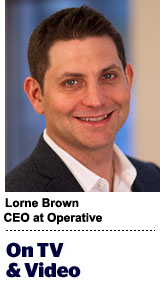 “On TV And Video” is a column exploring opportunities and challenges in programmatic TV and video.
“On TV And Video” is a column exploring opportunities and challenges in programmatic TV and video.
Today’s column is written by Lorne Brown, CEO at Operative.
I can’t tell you how many times I’ve heard high-level publishers and advertising executives bring up the huge promise of programmatic TV. In theory, programmatic TV buying allows advertisers to buy what they want and allows media companies to sell what they have more quickly and seamlessly.
However, especially for traditional TV executives, the complex dynamics of programmatic TV often deflate the conversation. In a guide explaining programmatic TV, for example, SpotX lists eight different video delivery formats to consider, each with their own terminology, metrics, data and technology.
There is no reason for most marketers and publishers to care about the difference between over-the-top, video on demand, streaming, addressable, first-party data or any other nuance of programmatic buying technology and operations. Instead, the conversations should center around the best way to profit from the advertisers who want to buy a specific audience across video channels.
But they can’t when everyone is scratching their heads trying to figure out what to make of the presentation by the latest programmatic TV vendors who use their own new terminology. TV buying and selling has been going quite well for the past 50 years, and with most inventory still sold directly at premium rates – and sold out, unlike digital – executives don’t need very many reasons to lose interest in trying something new.
Programmatic TV suffers from the same issue of almost every other feature of the ad tech ecosystem: It’s too complicated, which hurts its reputation that it should actually streamline activity. But unlike many other established channels, it’s early enough with programmatic TV that we can actually do something about it. And we must.
Publishers today have product catalogues that offer tens or even hundreds of different types of ad placements, from sizes and content types to channels and audience segments. The average sales or operations specialist already has to wrap their head around an enormous amount of complexity just to put an insertion order together, let alone run a campaign. Programmatic TV threatens to multiply this issue tenfold by introducing a bunch of thinly sliced mini-channels into what should be one large all-encompassing channel.
The first step in fixing programmatic TV’s problem is to agree on a cleaner definition. I’m going to throw out a blanket definition that programmatic TV is TV or video ads bought automatically by impression using audience data. You get the picture: The defining features are that it is automated, marries different forms of TV and video across many different delivery channels, focuses on impressions rather than GRPs and offers the benefit of audience targeting.
This definition will ensure that vendors can no longer microsegment themselves. If media companies think about this definition, then they can focus on how to profit from this method of buying and selling – which advertisers are asking for – rather than get stuck in the weeds.
The second step is for brands and publishers to designate someone within their company to be the programmatic TV specialist. This person should be somewhat technical, perhaps with a product background, but also capable of having business conversations that use real English words, not just jargon.
This person needs an executive champion that ensures access across the entire advertising yield curve from linear TV through to programmatic display in order to encourage seamless integration. The specialist should be the very highest-ranking person who considers issues such as how inventory will be sourced, how data will be transferred or how technologies will be integrated. Similar to other product conversations, executives can then be freed up to simply ask, “Are we ready to try programmatic TV?”
Finally, publisher executives must confront the complexity that operations teams have while managing so many fledgling technologies on the back end. Ideally, a consortium of brands and publishers will settle on a few mechanisms to buy and sell video programmatically at scale, but this hasn’t happened yet.
Operations teams need support as the industry forces everyone to try 10 different versions of the same thing. Publishers can take a hard line and put all of their inventory in one delivery system, but they will likely worry about missed buyers as a result. It’s time that leading buyers and sellers work together to simplify and streamline the first wave of converged audience-based advertising across all channels.
Follow Operative (@Operative) and AdExchanger (@adexchanger) on Twitter.












